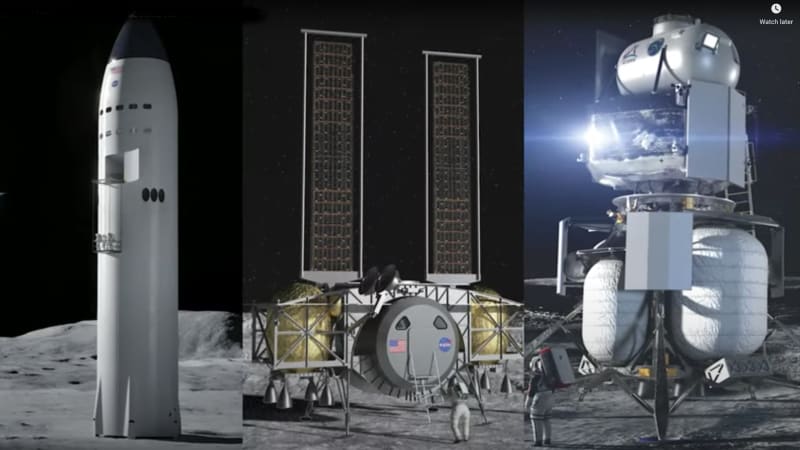
SpaceX’s lunar lander design, left, alongside those of Dynetics and Blue Origin.
WASHINGTON — NASA said on Friday it has awarded billionaire entrepreneur Elon Musk’s private space company SpaceX a $2.9 billion contract to build a spacecraft to bring astronauts to the moon as early as 2024, picking it over Jeff Bezos’ Blue Origin and defense contractor Dynetics Inc.
The bid by Tesla chief Musk beat one from Amazon.com founder Bezos, who had partnered with Lockheed Martin Corp, Northrop Grumman Corp and Draper. Bezos also owns the Washington Post.
The U.S. space agency made the announcement of the contract for the first commercial human lander, part of NASA’s as part of the Artemis program, in a video conference. NASA said the lander will carry two American astronauts to the lunar surface.
“We should accomplish the next landing as soon as possible,” said Steve Jurczyk, NASA’s acting administrator. “This is an incredible time to be involved in human exploration, for all humanity.”
“If they hit their milestones, we have a shot at 2024,” Jurczyk added.
NASA said it would require a test flight to the moon before humans make the flight.
“In addition, NASA is requiring a test flight to fully check out all systems with a landing on the lunar surface prior to our formal demonstration mission,” NASA official Lisa Watson-Morgan told reporters.
NASA official Mark Kirasich said the agency hopes to see all three of the companies that competed for the initial moon landing vying to provide recurring transportation to the moon.
“We have to be able to provide for recurring lunar services,” said Kirasich, deputy associate administrator for NASA’s Advanced Exploration Systems division, adding that NASA will work on a follow-on competition for “regularly recurring” lunar missions.
The NASA announcement added to an extraordinary run for Musk, who is one of the world’s richest people thanks to his 22% stake in electric car maker Tesla.
Tesla has become the world’s most-valuable automaker, with a market capitalization of $702 billion, far surpassing the auto industry’s giants. Musk has become a one-person technology conglomerate, launching or controlling companies pursuing space flight, electric cars, neural implants and subterranean tunnel boring.
A factor in the choice of SpaceX was “what’s the best value to the government,” said Kathy Lueders, associate administrator for NASA’s Human Exploration and Operations Mission Directorate.
NASA said in a news release that SpaceX’s HLS Starship, designed to land on the moon, “leans on the company’s tested Raptor engines and flight heritage of the Falcon and Dragon vehicles.” It said Starship includes a spacious cabin and two airlocks for astronaut moon walks and that its architecture is intended to evolve to a fully reusable launch and landing system designed for travel to the Moon, Mars and other destinations in space.
NASA’s decision was a setback for Bezos, a lifelong space enthusiast and one of the world’s richest people, who is now more focused on his space venture after having announced in February he would step down as Amazon CEO.
The contract was seen by Bezos and other executives as vital to Blue Origin establishing itself as a desired partner for NASA, and also putting the venture on the road to turning a profit, Reuters had reported in February.
SpaceX announced on Wednesday it had raised about $1.16 billion in equity financing.
Musk has outlined an ambitious agenda for SpaceX and its reusable rockets, including landing humans on Mars. But in the near term, SpaceX’s main business has been launching satellites for Musk’s Starlink internet venture, and other satellites and space cargo.
Unlike the Apollo lunar landings from 1969 to 1972, NASA now is gearing up for a long-term presence on the moon that it envisions as a steppingstone to an even more ambitious plan to send astronauts to reach Mars. NASA is leaning heavily on private companies built around shared visions for space exploration.
An uncrewed SpaceX Starship prototype rocket failed to land safely on March 30 after a test launch from Boca Chica, Texas. The Starship was one in a series of prototypes for the heavy-lift rocket being developed by SpaceX to carry humans and 100 tons of cargo on future missions to the moon and Mars. A first orbital Starship flight is planned for year’s end.
